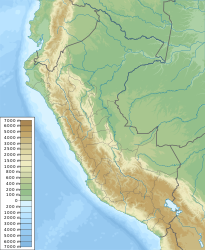Uchuraccay
| Uchuraccay | ||
|---|---|---|
|
|
||
| Coordinates | 12 ° 50 ′ S , 74 ° 7 ′ W | |
| Basic data | ||
| Country | Peru | |
| Ayacucho | ||
| province | Huanta | |
| ISO 3166-2 | PE-AYA | |
| District | Uchuraccay | |
| height | 4010 m | |
| Residents | 312 (2017) | |
Uchuraccay ( Hispanic , official spelling), in Chanka-Quechua Uchuraqay is a place with 312 inhabitants (2017 census) in the province of Huanta ( Ayacucho region ) in the Andean highlands of Peru , 4010 meters above sea level. Ten years earlier the population was 370.
Uchuraccay in the armed conflict in Peru
In July 1981 activists from Huamanga (Ayacucho) and Huanta of the Maoist guerrilla organization Sendero Luminoso ("Shining Path") began political work in Uchuraccay, but mostly met with opposition. In October 1982 the activists were expelled and a red flag that had been hoisted on a mountain shortly before was burned. In response to this, the Shining Path murdered Alejandro Huamán, the community leader of Uchuraccay, as one of the first political incumbents in its “People's War” at the end of November 1982.
On January 26, 1983 , as the armed conflict flared up in Peru, around 40 indigenous Quechua farmers murdered eight Peruvian journalists who had come from Lima to investigate a massacre carried out by the Shining Path in a neighboring community. Two other victims were an indigenous leader and a local resident.
As later investigations showed, the villagers, who lived in terrible fear of attacks by the terrorists, were ordered by the so-called Sinchis , a special unit of the Guardia Civil fighting the Shining Path, to kill all foreigners who came into the area by land they would come from the air (by helicopter ) themselves . Since the farmers hardly understood Spanish and the journalists did not speak Quechua , communication was very difficult, even though a companion, Juan Argumedo, spoke the indigenous language. As a result, the 10 victims were cruelly slain with agricultural implements.
The military chief of the Ayacucho Department, which is under martial law , Roberto Clemente Noel Moral , said on January 28 that the journalists had carried a red flag with them, which is why the villagers had acted in defense of the law with the bloodbath. He also suspected that the indigenous farmers might have interpreted the journalists' camera equipment as weapons.
A commission set up by the Peruvian President Fernando Belaúnde Terry and chaired by the writer Mario Vargas Llosa determined the perpetrators of the farmers and explained the crime with the backwardness of the farmers, without naming the spiritual complicity of the Sinchis . Mario Vargas Llosa repeated Noel's conjecture as a thesis that the farmers mistook cameras for weapons. This was later not confirmed by the Truth Commission. In 2015, the Tipe brothers refute claims about the backwardness of Uchuraccay: According to their investigations, the village had four shops, record players, sewing machines and, since the 1950s, a school. Relatives of the victims still believe that Sinchis were there at the time of the bloodbath.
Three of the farmers were sentenced to long prison terms in a later trial in Lima . A total of 17 villagers were sentenced, of whom, according to Tipe and Tipe, only one was alive in 2015 and lived hidden in the jungle area of Apurímac, Ene and Mantaro.
In the following months, 135 villagers, including 57 women, died in Uchuraccay. Most died in massacres committed by the Shining Path. The village should be punished for its resistance to the guerrilla organization. But attacks by the military and paramilitary groups affiliated with the government also cost numerous lives. The surviving villagers therefore left the village completely in the course of 1984 and fled to the jungle of the Amazon region , to neighboring towns and to Lima. In October 1993 the village was re-established with newly built houses away from the previous location.
The events in Uchuraqay are remembered in several Waynus , mostly in Chanka-Quechua , from Ayacucho.
People killed on January 26, 1983
- Eduardo De la Piniella y Pedro Sánchez (reporter for the daily newspaper El Diario de Marka )
- Félix Gavilán (correspondent for the daily newspaper El Diario de Marka )
- Willy Retto y Jorge Luis Mendívil (reporter for the daily newspaper El Observador )
- Jorge Sedano (reporter for the daily newspaper La República )
- Amador García (reporter for the weekly Oiga )
- Octavio Infante (reporter for the daily newspaper Noticias of Ayacucho)
- Juan Argumedo (group leader and interpreter)
- Severino Huáscar Morales (farmer from Uchuraccay who wanted to prevent the murder of Juan Argumedo)
literature
- Víctor Tipe Sánchez, Jaime Tipe Sánchez: Uchuraccay, el pueblo donde morían los que llegaban a pie . G7 Editores, Lima 2015.
Individual evidence
- ^ Huanta, Province in Ayacucho Region, Locality Uchuraccay . www.citypopulation.de. Retrieved November 18, 2019.
Web links
- Informe Final de la Comisión de la Verdad : 2.4. El caso Uchuraccay . Lima 2003.
- Un pasado de violencia, un futuro de paz 1980 - 2000 20 años de violencia / Qayna ñakariyninchik, paqarintaq hawkalla kawsakuyninchik 20 wata sipinakuy 1980 watamanta 2000 watakama. Publicación basada en el Informe Final de la Comisión de la Verdad y Reconciliación / Kaymi Chiqap Comisión riqsichisqan qillqa. Instituto de Democracia y Derechos Humanos de la Pontificia Universidad Católica del Perú , Lima 2008. pp. 11, 14.
- Chalena Vásquez R .: Uchuraqay en el canto popular. Lima, 2009.
